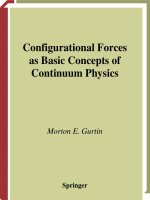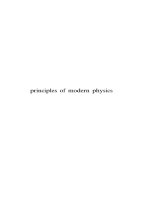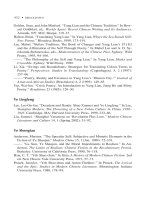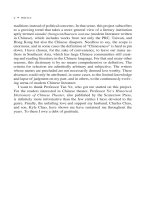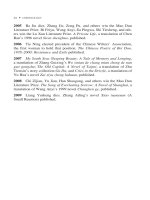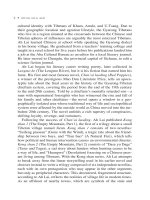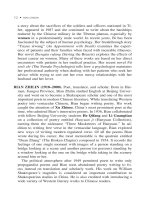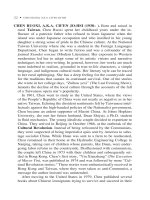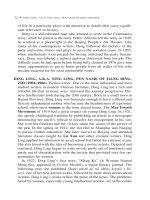- Trang chủ >>
- Khoa Học Tự Nhiên >>
- Vật lý
Concepts of modern physics 6th by beiser
Bạn đang xem bản rút gọn của tài liệu. Xem và tải ngay bản đầy đủ của tài liệu tại đây (8.99 MB, 559 trang )
bei48482_FM 1/11/02 2:54 PM Page i
Concepts of Modern
Physics
Sixth Edition
Arthur Beiser
Boston Burr Ridge, IL Dubuque, IA Madison, WI New York San Francisco St. Louis
Bangkok Bogotá Caracas Kuala Lumpur Lisbon London Madrid Mexico City
Milan Montreal New Delhi Santiago Seoul Singapore Sydney Taipei Toronto
bei48482_fm.qxd 4/8/03 20:42 Page ii RKAUL-7 Rkaul-07:Desktop Folder:bei:
McGraw-Hill Higher Education
A Division of The McGraw-Hill Companies
CONCEPTS OF MODERN PHYSICS, SIXTH EDITION
Published by McGraw-Hill, a business unit of The McGraw-Hill Companies, Inc., 1221
Avenue of the Americas, New York, NY 10020. Copyright © 2003, 1995, 1987, 1981,
1973, 1967, 1963 by The McGraw-Hill Companies, Inc. All rights reserved. No part of
this publication may be reproduced or distributed in any form or by any means, or stored
in a database or retrieval system, without the prior written consent of The McGraw-Hill
Companies, Inc., including, but not limited to, in any network or other electronic storage
or transmission, or broadcast for distance learning.
Some ancillaries, including electronic and print components, may not be available to customers
outside the United States.
This book is printed on acid-free paper.
International
Domestic
1 2 3 4 5 6 7 8 9 0 VNH/VNH 0 9 8 7 6 5 4 3 2
2 3 4 5 6 7 8 9 0 VNH/VNH 0 9 8 7 6 5 4 3
ISBN 0–07–244848–2
ISBN 0–07–115096–X (ISE)
Publisher: Kent A. Peterson
Sponsoring editor: Daryl Bruflodt
Developmental editor: Mary E. Haas
Marketing manager: Debra B. Hash
Senior project manager: Joyce M. Berendes
Senior production supervisor: Laura Fuller
Coordinator of freelance design: Rick D. Noel
Interior design: Kathleen Theis
Cover design: Joshua Van Drake
Cover image: Courtesy of Brookhaven National Laboratory, Soleniodal Tracker At RHIC (STAR)
Experiment. Image: First Gold Beam-Beam Collision Events at Relativistic Heavy Ion Collider.
Senior photo research coordinator: Lori Hancock
Photo research: Chris Hammond/Photo Find LLC
Senior supplement producer: Tammy Juran
Compositor: TECHBOOKS
Typeface: 10/12 Berkley Old Style
Printer: Von Hoffmann Press, Inc.
The credits section for this book begins on page 529 and is considered an extension of the
copyright page.
Library of Congress Cataloging-in-Publication Data
Beiser, Arthur.
Concepts of modern physics. — 6th ed. / Arthur Beiser
p.
cm.
Includes index.
ISBN 0–07–244848–2
1. Physics. II. Title.
QC21.3 .B45 2003
2001044743
CIP
INTERNATIONAL EDITION ISBN 0–07–115096–X
Copyright © 2003. Exclusive rights by The McGraw-Hill Companies, Inc., for manufacture
and export. This book cannot be re-exported from the country to which it is sold by McGraw-Hill.
The International Edition is not available in North America.
www.mhhe.com
bei48482_FM 2/4/02 12:12 PM Page iii
Contents
Preface
xii
CHAPTER
Relativity
1
1
1.1
Special Relativity
2
All motion is relative; the speed of light in free space is the same
for all observers
1.2 Time Dilation
5
A moving clock ticks more slowly than a clock at rest
1.3 Doppler Effect
10
Why the universe is believed to be expanding
1.4 Length Contraction
15
Faster means shorter
1.5 Twin Paradox
17
A longer life, but it will not seem longer
1.6 Electricity and Magnetism
19
Relativity is the bridge
1.7 Relativistic Momentum
22
Redefining an important quantity
1.8 Mass and Energy
26
2
Where E0 ϭ mc comes from
1.9 Energy and Momentum
30
How they fit together in relativity
1.10 General Relativity
33
Gravity is a warping of spacetime
APPENDIX I: The Lorentz Transformation
37
APPENDIX II: Spacetime
46
iii
bei48482_FM 1/11/02 2:54 PM Page iv
iv
Contents
CHAPTER
2
Particle Properties of Waves
2.1
2.2
2.3
2.4
2.5
2.6
2.7
2.8
2.9
Electromagnetic Waves
53
Coupled electric and magnetic oscillations that move with the speed of
light and exhibit typical wave behavior
Blackbody Radiation
57
Only the quantum theory of light can explain its origin
Photoelectric Effect
62
The energies of electrons liberated by light depend on the frequency
of the light
What Is Light?
67
Both wave and particle
X-Rays
68
They consist of high-energy photons
X-Ray Diffraction
72
How x-ray wavelengths can be determined
Compton Effect
75
Further confirmation of the photon model
Pair Production
79
Energy into matter
Photons and Gravity
85
Although they lack rest mass, photons behave as though they have
gravitational mass
CHAPTER
3
Wave Properties of Particles
3.1
3.2
3.3
3.4
3.5
52
92
De Broglie Waves
93
A moving body behaves in certain ways as though it has a wave nature
Waves of What?
95
Waves of probability
Describing a Wave
96
A general formula for waves
Phase and Group Velocities
99
A group of waves need not have the same velocity as the waves
themselves
Particle Diffraction
104
An experiment that confirms the existence of de Broglie waves
bei48482_FM 1/11/02 2:54 PM Page v
Contents
3.6
3.7
3.8
3.9
Particle in a Box
106
Why the energy of a trapped particle is quantized
Uncertainty Principle I
108
We cannot know the future because we cannot know the present
Uncertainty Principle II
113
A particle approach gives the same result
Applying the Uncertainty Principle
114
A useful tool, not just a negative statement
CHAPTER
4
Atomic Structure
119
4.1
The Nuclear Atom
120
An atom is largely empty space
4.2 Electron Orbits
124
The planetary model of the atom and why it fails
4.3 Atomic Spectra
127
Each element has a characteristic line spectrum
4.4 The Bohr Atom
130
Electron waves in the atom
4.5 Energy Levels and Spectra
133
A photon is emitted when an electron jumps from one energy level to a
lower level
4.6 Correspondence Principle
138
The greater the quantum number, the closer quantum physics approaches
classical physics
4.7 Nuclear Motion
140
The nuclear mass affects the wavelengths of spectral lines
4.8 Atomic Excitation
142
How atoms absorb and emit energy
4.9 The Laser
145
How to produce light waves all in step
APPENDIX: Rutherford Scattering
152
CHAPTER
5
Quantum Mechanics
5.1
160
Quantum Mechanics
161
Classical mechanics is an approximation of quantum mechanics
v
bei48482_FM 1/11/02 2:54 PM Page vi
vi
Contents
5.2
The Wave Equation
163
It can have a variety of solutions, including complex ones
5.3 Schrödinger’s Equation: Time-Dependent Form
166
A basic physical principle that cannot be derived from anything else
5.4 Linearity and Superposition
169
Wave functions add, not probabilities
5.5 Expectation Values
170
How to extract information from a wave function
5.6 Operators
172
Another way to find expectation values
5.7 Schrödinger’s Equation: Steady-State Form
174
Eigenvalues and eigenfunctions
5.8 Particle in a Box
177
How boundary conditions and normalization determine wave functions
5.9 Finite Potential Well
183
The wave function penetrates the walls, which lowers the energy levels
5.10 Tunnel Effect
184
A particle without the energy to pass over a potential barrier may still
tunnel through it
5.11 Harmonic Oscillator
187
Its energy levels are evenly spaced
APPENDIX: The Tunnel Effect
193
CHAPTER
6
Quantum Theory of the Hydrogen Atom
6.1
6.2
6.3
6.4
6.5
6.6
Schrödinger’s Equation for the Hydrogen Atom
Symmetry suggests spherical polar coordinates
Separation of Variables
203
A differential equation for each variable
Quantum Numbers
205
Three dimensions, three quantum numbers
Principal Quantum Number
207
Quantization of energy
Orbital Quantum Number
208
Quantization of angular-momentum magnitude
Magnetic Quantum Number
210
Quantization of angular-momentum direction
200
201
bei48482_FM 1/11/02 2:54 PM Page vii
Contents
6.7
6.8
6.9
6.10
Electron Probability Density
212
No definite orbits
Radiative Transitions
218
What happens when an electron goes from one state to another
Selection Rules
220
Some transitions are more likely to occur than others
Zeeman Effect
223
How atoms interact with a magnetic field
CHAPTER
7
Many-Electron Atoms
228
7.1
Electron Spin
229
Round and round it goes forever
7.2 Exclusion Principle
231
A different set of quantum numbers for each electron in an atom
7.3 Symmetric and Antisymmetric Wave Functions
233
Fermions and bosons
7.4 Periodic Table
235
Organizing the elements
7.5 Atomic Structures
238
Shells and subshells of electrons
7.6 Explaining the Periodic Table
240
How an atom’s electron structure determines its chemical behavior
7.7 Spin-Orbit Coupling
247
Angular momenta linked magnetically
7.8 Total Angular Momentum
249
Both magnitude and direction are quantized
7.9 X-Ray Spectra
254
They arise from transitions to inner shells
APPENDIX: Atomic Spectra
259
CHAPTER
8
Molecules
266
8.1
The Molecular Bond
267
Electric forces hold atoms together to form molecules
vii
bei48482_FM 1/11/02 2:54 PM Page viii
viii
Contents
8.2
8.3
8.4
8.5
8.6
8.7
8.8
Electron Sharing
269
The mechanism of the covalent bond
The H2ϩ Molecular Ion
270
Bonding requires a symmetric wave function
The Hydrogen Molecule
274
The spins of the electrons must be antiparallel
Complex Molecules
276
Their geometry depends on the wave functions of the outer electrons of
their atoms
Rotational Energy Levels
282
Molecular rotational spectra are in the microwave region
Vibrational Energy Levels
285
A molecule may have many different modes of vibration
Electronic Spectra of Molecules
291
How fluorescence and phsophorescence occur
CHAPTER
9
Statistical Mechanics
9.1
9.2
9.3
9.4
9.5
9.6
9.7
9.8
9.9
296
Statistical Distributions
297
Three different kinds
Maxwell-Boltzmann Statistics
298
Classical particles such as gas molecules obey them
Molecular Energies in an Ideal Gas
300
3
They vary about an average of ᎏ2ᎏ kT
Quantum Statistics
305
Bosons and fermions have different distribution functions
Rayleigh-Jeans Formula
311
The classical approach to blackbody radiation
Planck Radiation Law
313
How a photon gas behaves
Einstein’s Approach
318
Introducing stimulated emission
Specific Heats of Solids
320
Classical physics fails again
Free Electrons in a Metal
323
No more than one electron per quantum state
bei48482_FM 1/11/02 2:54 PM Page ix
Contents
9.10
9.11
Electron-Energy Distribution
325
Why the electrons in a metal do not contribute to its specific heat except
at very high and very low temperatures
Dying Stars
327
What happens when a star runs out of fuel
CHAPTER
The Solid State
10.1
10.2
10.3
10.4
10.5
10.6
10.7
10.8
10.9
10.10
10
335
Crystalline and Amorphous Solids
336
Long-range and short-range order
Ionic Crystals
338
The attraction of opposites can produce a stable union
Covalent Crystals
342
Shared electrons lead to the strongest bonds
Van der Waals Bond
345
Weak but everywhere
Metallic Bond
348
A gas of free electrons is responsible for the characteristic properties
of a metal
Band Theory of Solids
354
The energy band structure of a solid determines whether it is a conductor,
an insulator, or a semiconductor
Semiconductor Devices
361
The properties of the p-n junction are responsible for the microelectronics
industry
Energy Bands: Alternative Analysis
369
How the periodicity of a crystal lattice leads to allowed and forbidden bands
Superconductivity
376
No resistance at all, but only at very low temperatures (so far)
Bound Electron Pairs
381
The key to superconductivity
CHAPTER
11
Nuclear Structure
387
11.1
Nuclear Composition
388
Atomic nuclei of the same element have the same numbers of protons
but can have different numbers of neutrons
ix
bei48482_FM 1/11/02 2:54 PM Page x
x
Contents
11.2
11.3
11.4
11.5
11.6
11.7
Some Nuclear Properties
392
Small in size, a nucleus may have angular momentum and a magnetic
moment
Stable Nuclei
396
Why some combinations of neutrons and protons are more stable
than others
Binding Energy
399
The missing energy that keeps a nucleus together
Liquid-Drop Model
403
A simple explanation for the binding-energy curve
Shell Model
408
Magic numbers in the nucleus
Meson Theory of Nuclear Forces
412
Particle exchange can produce either attraction or repulsion
CHAPTER
12
Nuclear Transformations
12.1
12.2
12.3
12.4
12.5
12.6
12.7
12.8
12.9
12.10
418
Radioactive Decay
419
Five kinds
Half-Life
424
Less and less, but always some left
Radioactive Series
430
Four decay sequences that each end in a stable daughter
Alpha Decay
432
Impossible in classical physics, it nevertheless occurs
Beta Decay
436
Why the neutrino should exist and how it was discovered
Gamma Decay
440
Like an excited atom, an excited nucleus can emit a photon
Cross Section
441
A measure of the likelihood of a particular interaction
Nuclear Reactions
446
In many cases, a compound nucleus is formed first
Nuclear Fission
450
Divide and conquer
Nuclear Reactors
454
2
E0 ϭ mc ϩ $$$
bei48482_FM 2/4/02 2:27 PM Page xi
Contents
12.11
Nuclear Fusion in Stars
460
How the sun and stars get their energy
12.12 Fusion Reactors
463
The energy source of the future?
APPENDIX: Theory of Alpha Decay
468
CHAPTER
13
Elementary Particles
13.1
13.2
13.3
13.4
13.5
13.6
13.7
13.8
13.9
474
Interactions and Particles
475
Which affects which
Leptons
477
Three pairs of truly elementary particles
Hadrons
481
Particles subject to the strong interaction
Elementary Particle Quantum Numbers
485
Finding order in apparent chaos
Quarks
489
The ultimate constituents of hadrons
Field Bosons
494
Carriers of the interactions
The Standard Model and Beyond
496
Putting it all together
History of the Universe
498
It began with a bang
The Future
501
“In my beginning is my end.” (T. S. Eliot, Four Quartets)
APPENDIX
Atomic Masses
507
Answers to Odd-Numbered Exercises
For Further Study
Credits
Index
529
531
525
516
xi
bei48482_FM 1/11/02 2:54 PM Page xii
Preface
odern physics began in 1900 with Max Planck’s discovery of the role of energy
quantization in blackbody radiation, a revolutionary idea soon followed by
Albert Einstein’s equally revolutionary theory of relativity and quantum theory of light. Students today must wonder why the label “modern” remains attached to
this branch of physics. Yet it is not really all that venerable: my father was born in
1900, for instance, and when I was learning modern physics most of its founders, including Einstein, were still alive; I even had the privilege of meeting a number of them,
including Heisenberg, Pauli, and Dirac. Few aspects of contemporary science—indeed,
of contemporary life—are unaffected by the insights into matter and energy provided
by modern physics, which continues as an active discipline as it enters its second
century.
This book is intended to be used with a one-semester course in modern physics for
students who have already had basic physics and calculus courses. Relativity and
quantum ideas are considered first to provide a framework for understanding the
physics of atoms and nuclei. The theory of the atom is then developed with emphasis
on quantum-mechanical notions. Next comes a discussion of the properties of aggregates of atoms, which includes a look at statistical mechanics. Finally atomic nuclei
and elementary particles are examined.
The balance in this book leans more toward ideas than toward experimental methods and practical applications, because I believe that the beginning student is better
served by a conceptual framework than by a mass of details. For a similar reason the
sequence of topics follows a logical rather than strictly historical order. The merits of
this approach have led to the extensive worldwide use of the five previous editions of
Concepts of Modern Physics, including translations into a number of other languages,
since the first edition appeared nearly forty years ago.
Wherever possible, important subjects are introduced on an elementary level, which
enables even relatively unprepared students to understand what is going on from the
start and also encourages the development of physical intuition in readers in whom
the mathematics (rather modest) inspires no terror. More material is included than can
easily be covered in one semester. Both factors give scope to an instructor to fashion
the type of course desired, whether a general survey, a deeper inquiry into selected
subjects, or a combination of both.
Like the text, the exercises are on all levels, from the quite easy (for practice and
reassurance) to those for which real thought is needed (for the joy of discovery). The
exercises are grouped to correspond to sections of the text with answers to the oddnumbered exercises given at the back of the book. In addition, a Student Solutions
Manual has been prepared by Craig Watkins that contains solutions to the oddnumbered exercises.
Because the ideas of modern physics represented totally new directions in thought
when first proposed, rather than extensions of previous knowledge, the story of their
development is exceptionally interesting. Although there is no room here for a full account, bits and pieces are included where appropriate, and thirty-nine brief biographies of important contributors are sprinkled through the text to help provide a human persepctive. Many books on the history of modern physics are available for those
M
xii
bei48482_FM 2/4/02 11:13 AM Page xiii
Preface
who wish to go further into this subject; those by Abraham Pais and by Emilio Segré,
themselves distinguished physicists, are especially recommended.
For this edition of Concepts of Modern Physics the treatments of special relativity,
quantum mechanics, and elementary particles received major revisions. In addition,
numerous smaller changes and updates were made throughout the book, and several
new topics were added, for instance Einstein’s derivation of the Planck radiation law.
There is more material on aspects of astrophysics that nicely illustrate important elements of modern physics, which for this reason are discussed where relevant in the
text rather than being concentrated in a single chapter.
Many students, although able to follow the arguments in the book, nevertheless may
have trouble putting their knowledge to use. To help them, each chapter has a selection of worked examples. Together with those in the Solutions Manual, over 350 solutions are thus available to problems that span all levels of difficulty. Understanding
these solutions should bring the unsolved even-numbered exercises within reach.
In revising Concepts of Modern Physics for the sixth edition I have had the benefit of
constructive criticism from the following reviewers, whose generous assistance was
of great value: Steven Adams, Widener University; Amitava Bhattacharjee, The University of Iowa; William E. Dieterle, California University of Pennsylvania; Nevin D. Gibson,
Denison University; Asif Khand Ker, Millsaps College; Teresa Larkin-Hein, American
University; Jorge A. López, University of Texas at El Paso; Carl A. Rotter, West Virginia
University; and Daniel Susan, Texas A&M University–Kingsville. I am also grateful to the
following reviewers of previous editions for their critical reviews and comments: Donald
R. Beck, Michigan Technological University; Ronald J. Bieniek, University of Missouri–Rolla;
Lynn R. Cominsky, Sonoma State University; Brent Cornstubble, United States Military
Academy; Richard Gass, University of Cincinnati; Nicole Herbot, Arizona State University; Vladimir Privman, Clarkson University; Arnold Strassenberg, State University of New
York–Stony Brook; the students at Clarkson and Arizona State Universities who evaluated
an earlier edition from their point of view; and Paul Sokol of Pennsylvania State University who supplied a number of excellent exercises. I am especially indebted to Craig
Watkins of Massachusetts Institute of Technology who went over the manuscript with a
meticulous and skeptical eye and who checked the answers to all the exercises. Finally,
I want to thank my friends at McGraw-Hill for their skilled and enthusiastic help
throughout the project.
Arthur Beiser
xiii
bei48482_FM 1/11/02 2:54 PM Page xiv
Concepts of Modern
Physics
Sixth Edition
bei48482_ch01.qxd 1/15/02 1:20 AM Page 1
CHAPTER 1
Relativity
According to the theory of relativity, nothing can travel faster than light. Although today’s spacecraft can
exceed 10 km/s, they are far from this ultimate speed limit.
1.1
1.2
1.3
1.4
1.5
1.6
SPECIAL RELATIVITY
All motion is relative; the speed of light in free
space is the same for all observers
TIME DILATION
A moving clock ticks more slowly than a clock
at rest
DOPPLER EFFECT
Why the universe is believed to be expanding
LENGTH CONTRACTION
Faster means shorter
TWIN PARADOX
A longer life, but it will not seem longer
ELECTRICITY AND MAGNETISM
Relativity is the bridge
1.7
RELATIVISTIC MOMENTUM
Redefining an important quantity
1.8
MASS AND ENERGY
Where E0 ϭ mc2 comes from
1.9
ENERGY AND MOMENTUM
How they fit together in relativity
1.10 GENERAL RELATIVITY
Gravity is a warping of spacetime
APPENDIX I: THE LORENTZ
TRANSFORMATION
APPENDIX II: SPACETIME
1
bei48482_ch01.qxd 1/15/02 1:20 AM Page 2
2
Chapter One
n 1905 a young physicist of twenty-six named Albert Einstein showed how measurements of time and space are affected by motion between an observer and what
is being observed. To say that Einstein’s theory of relativity revolutionized science
is no exaggeration. Relativity connects space and time, matter and energy, electricity
and magnetism—links that are crucial to our understanding of the physical universe.
From relativity have come a host of remarkable predictions, all of which have been
confirmed by experiment. For all their profundity, many of the conclusions of relativity
can be reached with only the simplest of mathematics.
I
1.1 SPECIAL RELATIVITY
All motion is relative; the speed of light in free space is the same for all
observers
When such quantities as length, time interval, and mass are considered in elementary
physics, no special point is made about how they are measured. Since a standard unit
exists for each quantity, who makes a certain determination would not seem to matter—
everybody ought to get the same result. For instance, there is no question of principle
involved in finding the length of an airplane when we are on board. All we have to do
is put one end of a tape measure at the airplane’s nose and look at the number on the
tape at the airplane’s tail.
But what if the airplane is in flight and we are on the ground? It is not hard to determine the length of a distant object with a tape measure to establish a baseline, a
surveyor’s transit to measure angles, and a knowledge of trigonometry. When we measure the moving airplane from the ground, though, we find it to be shorter than it is
to somebody in the airplane itself. To understand how this unexpected difference arises
we must analyze the process of measurement when motion is involved.
Frames of Reference
The first step is to clarify what we mean by motion. When we say that something is
moving, what we mean is that its position relative to something else is changing. A
passenger moves relative to an airplane; the airplane moves relative to the earth; the
earth moves relative to the sun; the sun moves relative to the galaxy of stars (the Milky
Way) of which it is a member; and so on. In each case a frame of reference is part of
the description of the motion. To say that something is moving always implies a specific
frame of reference.
An inertial frame of reference is one in which Newton’s first law of motion holds.
In such a frame, an object at rest remains at rest and an object in motion continues to
move at constant velocity (constant speed and direction) if no force acts on it. Any
frame of reference that moves at constant velocity relative to an inertial frame is itself
an inertial frame.
All inertial frames are equally valid. Suppose we see something changing its position with respect to us at constant velocity. Is it moving or are we moving? Suppose
we are in a closed laboratory in which Newton’s first law holds. Is the laboratory moving or is it at rest? These questions are meaningless because all constant-velocity motion
is relative. There is no universal frame of reference that can be used everywhere, no
such thing as “absolute motion.”
The theory of relativity deals with the consequences of the lack of a universal frame
of reference. Special relativity, which is what Einstein published in 1905, treats
bei48482_ch01.qxd 1/15/02 1:20 AM Page 3
Relativity
problems that involve inertial frames of reference. General relativity, published by
Einstein a decade later, describes the relationship between gravity and the geometrical
structure of space and time. The special theory has had an enormous impact on much
of physics, and we shall concentrate on it here.
Postulates of Special Relativity
Two postulates underlie special relativity. The first, the principle of relativity, states:
The laws of physics are the same in all inertial frames of reference.
This postulate follows from the absence of a universal frame of reference. If the laws
of physics were different for different observers in relative motion, the observers could
find from these differences which of them were “stationary” in space and which were
“moving.” But such a distinction does not exist, and the principle of relativity expresses
this fact.
The second postulate is based on the results of many experiments:
The speed of light in free space has the same value in all inertial frames of
reference.
This speed is 2.998 ϫ 108 m/s to four significant figures.
To appreciate how remarkable these postulates are, let us look at a hypothetical
experiment basically no different from actual ones that have been carried out in a
number of ways. Suppose I turn on a searchlight just as you fly past in a spacecraft
at a speed of 2 ϫ 108 m /s (Fig. 1.1). We both measure the speed of the light waves
from the searchlight using identical instruments. From the ground I find their speed
to be 3 ϫ 108 m /s as usual. “Common sense” tells me that you ought to find a speed
of (3 Ϫ 2) ϫ 108 m/s, or only 1 ϫ 108 m /s, for the same light waves. But you also
find their speed to be 3 ϫ 108 m/s, even though to me you seem to be moving parallel
to the waves at 2 ϫ 108 m/s.
v = 2 ✕ 108 m/s
c = 3 ✕ 108 m/s
c = 3 ✕ 108 m/s
(a)
( b)
Figure 1.1 The speed of light is the same to all observers.
(c)
3
bei48482_ch01.qxd 1/15/02 1:21 AM Page 4
4
Chapter One
Albert A. Michelson (1852–1931)
was born in Germany but came to the
United States at the age of two with
his parents, who settled in Nevada. He
attended the U.S. Naval Academy at
Annapolis where, after two years of sea
duty, he became a science instructor.
To improve his knowledge of optics,
in which he wanted to specialize,
Michelson went to Europe and studied in Berlin and Paris. Then he left
the Navy to work first at the Case School of Applied Science in
Ohio, then at Clark University in Massachusetts, and finally at
the University of Chicago, where he headed the physics department from 1892 to 1929. Michelson’s speciality was highprecision measurement, and for many decades his successive
figures for the speed of light were the best available. He redefined the meter in terms of wavelengths of a particular spectral
line and devised an interferometer that could determine the
diameter of a star (stars appear as points of light in even the
most powerful telescopes).
Michelson’s most significant achievement, carried out in
1887 in collaboration with Edward Morley, was an experiment
to measure the motion of the earth through the “ether,” a hypothetical medium pervading the universe in which light waves
were supposed to occur. The notion of the ether was a hangover from the days before light waves were recognized as electromagnetic, but nobody at the time seemed willing to discard
the idea that light propagates relative to some sort of universal
frame of reference.
To look for the earth’s motion through the ether, Michelson
and Morley used a pair of light beams formed by a half-silvered
mirror, as in Fig. 1.2. One light beam is directed to a mirror
along a path perpendicular to the ether current, and the other
goes to a mirror along a path parallel to the ether current. Both
beams end up at the same viewing screen. The clear glass plate
ensures that both beams pass through the same thicknesses of
air and glass. If the transit times of the two beams are the same,
they will arrive at the screen in phase and will interfere constructively. An ether current due to the earth’s motion parallel
to one of the beams, however, would cause the beams to have
different transit times and the result would be destructive interference at the screen. This is the essence of the experiment.
Although the experiment was sensitive enough to detect the
expected ether drift, to everyone’s surprise none was found.
The negative result had two consequences. First, it showed that
the ether does not exist and so there is no such thing as “absolute motion” relative to the ether: all motion is relative to a
specified frame of reference, not to a universal one. Second, the
result showed that the speed of light is the same for all observers, which is not true of waves that need a material medium
in which to occur (such as sound and water waves).
The Michelson-Morley experiment set the stage for Einstein’s
1905 special theory of relativity, a theory that Michelson himself was reluctant to accept. Indeed, not long before the flowering of relativity and quantum theory revolutionized physics,
Michelson announced that “physical discoveries in the future
are a matter of the sixth decimal place.” This was a common
opinion of the time. Michelson received a Nobel Prize in 1907,
the first American to do so.
Mirror A
Path A
Glass plate
Parallel light
from
single source
Path B
Mirror B
Half-silvered mirror
v
Viewing screen
Figure 1.2 The Michelson-Morley experiment.
Hypothetical
ether current
bei48482_ch01.qxd 1/15/02 1:21 AM Page 5
Relativity
There is only one way to account for these results without violating the principle of
relativity. It must be true that measurements of space and time are not absolute but depend on the relative motion between an observer and what is being observed. If I were
to measure from the ground the rate at which your clock ticks and the length of your
meter stick, I would find that the clock ticks more slowly than it did at rest on the ground
and that the meter stick is shorter in the direction of motion of the spacecraft. To you,
your clock and meter stick are the same as they were on the ground before you took off.
To me they are different because of the relative motion, different in such a way that the
speed of light you measure is the same 3 ϫ 108 m/s I measure. Time intervals and lengths
are relative quantities, but the speed of light in free space is the same to all observers.
Before Einstein’s work, a conflict had existed between the principles of mechanics,
which were then based on Newton’s laws of motion, and those of electricity and
magnetism, which had been developed into a unified theory by Maxwell. Newtonian
mechanics had worked well for over two centuries. Maxwell’s theory not only covered
all that was then known about electric and magnetic phenomena but had also predicted that electromagnetic waves exist and identified light as an example of them.
However, the equations of Newtonian mechanics and those of electromagnetism differ
in the way they relate measurements made in one inertial frame with those made in a
different inertial frame.
Einstein showed that Maxwell’s theory is consistent with special relativity whereas
Newtonian mechanics is not, and his modification of mechanics brought these branches
of physics into accord. As we will find, relativistic and Newtonian mechanics agree for
relative speeds much lower than the speed of light, which is why Newtonian mechanics
seemed correct for so long. At higher speeds Newtonian mechanics fails and must be
replaced by the relativistic version.
1.2 TIME DILATION
A moving clock ticks more slowly than a clock at rest
Measurements of time intervals are affected by relative motion between an observer
and what is observed. As a result, a clock that moves with respect to an observer ticks
more slowly than it does without such motion, and all processes (including those of
life) occur more slowly to an observer when they take place in a different inertial frame.
If someone in a moving spacecraft finds that the time interval between two events
in the spacecraft is t0, we on the ground would find that the same interval has the
longer duration t. The quantity t0, which is determined by events that occur at the same
place in an observer’s frame of reference, is called the proper time of the interval
between the events. When witnessed from the ground, the events that mark the beginning and end of the time interval occur at different places, and in consequence the
duration of the interval appears longer than the proper time. This effect is called time
dilation (to dilate is to become larger).
To see how time dilation comes about, let us consider two clocks, both of the particularly simple kind shown in Fig. 1.3. In each clock a pulse of light is reflected back
and forth between two mirrors L0 apart. Whenever the light strikes the lower mirror,
an electric signal is produced that marks the recording tape. Each mark corresponds
to the tick of an ordinary clock.
One clock is at rest in a laboratory on the ground and the other is in a spacecraft
that moves at the speed relative to the ground. An observer in the laboratory watches
both clocks: does she find that they tick at the same rate?
5
bei48482_ch01.qxd 1/15/02 1:21 AM Page 6
6
Chapter One
Mirror
Meter stick
Recording device
L0
“Ticks”
Light pulse
Mirror
Photosensitive surface
Figure 1.3 A simple clock. Each “tick” corresponds to a round trip of the light pulse from the lower
mirror to the upper one and back.
Figure 1.4 shows the laboratory clock in operation. The time interval between ticks
is the proper time t0 and the time needed for the light pulse to travel between the
mirrors at the speed of light c is t0 ͞2. Hence t0 ͞2 ϭ L 0 ͞c and
0
–t
2
t
2L 0
t0 ϭ ᎏ
c
(1.1)
Figure 1.5 shows the moving clock with its mirrors perpendicular to the direction
of motion relative to the ground. The time interval between ticks is t. Because the clock
is moving, the light pulse, as seen from the ground, follows a zigzag path. On its way
from the lower mirror to the upper one in the time t͞2, the pulse travels a horizontal
distance of (t͞2) and a total distance of c(t͞2). Since L0 is the vertical distance between
the mirrors,
ct
Figure 1.4 A light-pulse clock at
rest on the ground as seen by an
observer on the ground. The dial
represents a conventional clock on
the ground.
ᎏ2
2
t
ϭ L20 ϩ ᎏ
2
2
t2
ᎏ (c2 Ϫ 2) ϭ L20
4
(2L0)2
4L20
ᎏᎏ
t2 ϭ ᎏ
ϭ
c2 Ϫ 2
c2(1 Ϫ 2͞c2)
tϭ
2L0͞c
ᎏᎏ
͙ෆ
1 Ϫ 2͞c
ෆ2
(1.2)
But 2L 0 ͞c is the time interval t0 between ticks on the clock on the ground, as in
Eq. (1.1), and so
bei48482_ch01.qxd 1/15/02 1:21 AM Page 7
Relativity
0
–t
2
t
v
t
c–
2
L0
v
v –t
2
Figure 1.5 A light-pulse clock in a spacecraft as seen by an observer on the ground. The mirrors are
parallel to the direction of motion of the spacecraft. The dial represents a conventional clock on the
ground.
Time dilation
tϭ
t0
ᎏᎏ
͙1ෆ
Ϫ 2ෆ
͞c2
(1.3)
Here is a reminder of what the symbols in Eq. (1.4) represent:
t0 ϭ time interval on clock at rest relative to an observer ϭ proper time
t ϭ time interval on clock in motion relative to an observer
ϭ speed of relative motion
c ϭ speed of light
Because the quantity ͙ෆ
1 Ϫ 2ෆ
͞c2 is always smaller than 1 for a moving object, t is
always greater than t0. The moving clock in the spacecraft appears to tick at a slower
rate than the stationary one on the ground, as seen by an observer on the ground.
Exactly the same analysis holds for measurements of the clock on the ground by
the pilot of the spacecraft. To him, the light pulse of the ground clock follows a zigzag
path that requires a total time t per round trip. His own clock, at rest in the spacecraft,
ticks at intervals of t0. He too finds that
tϭ
t0
ᎏᎏ
͙1ෆ
Ϫ 2ෆ
͞c2
so the effect is reciprocal: every observer finds that clocks in motion relative to him
tick more slowly than clocks at rest relative to him.
Our discussion has been based on a somewhat unusual clock. Do the same conclusions
apply to ordinary clocks that use machinery—spring-controlled escapements, tuning
forks, vibrating quartz crystals, or whatever—to produce ticks at constant time intervals?
The answer must be yes, since if a mirror clock and a conventional clock in the spacecraft agree with each other on the ground but not when in flight, the disagreement
between then could be used to find the speed of the spacecraft independently of any
outside frame of reference—which contradicts the principle that all motion is relative.
7
bei48482_ch01.qxd 1/15/02 1:21 AM Page 8
8
Chapter One
The Ultimate Speed Limit
T
he earth and the other planets of the solar system seem to be natural products of the evolution of the sun. Since the sun is a rather ordinary star in other ways, it is not surprising that
other stars have been found to have planetary systems around them as well. Life developed here
on earth, and there is no known reason why it should not also have done so on some of these
planets. Can we expect ever to be able to visit them and meet our fellow citizens of the universe?
The trouble is that nearly all stars are very far away—thousands or millions of light-years away. (A
light-year, the distance light travels in a year, is 9.46 ϫ 1015 m.) But if we can build a spacecraft
whose speed is thousands or millions of times greater than the speed of light c, such distances
would not be an obstacle.
Alas, a simple argument based on Einstein’s postulates shows that nothing can move faster
than c. Suppose you are in a spacecraft traveling at a constant speed relative to the earth that
is greater than c. As I watch from the earth, the lamps in the spacecraft suddenly go out. You
switch on a flashlight to find the fuse box at the front of the spacecraft and change the blown
fuse (Fig. 1.6a). The lamps go on again.
From the ground, though, I would see something quite different. To me, since your speed
is greater than c, the light from your flashlight illuminates the back of the spacecraft (Fig. 1.6b).
I can only conclude that the laws of physics are different in your inertial frame from what they
are in my inertial frame—which contradicts the principle of relativity. The only way to avoid
this contradiction is to assume that nothing can move faster than the speed of light. This assumption has been tested experimentally many times and has always been found to be correct.
The speed of light c in relativity is always its value in free space of 3.00 ϫ 108 m/s. In all material media, such as air, water, or glass, light travels more slowly than this, and atomic particles
are able to move faster in such media than does light. When an electrically charged particle moves
through a transparent substance at a speed exceeding that of light in the substance, a cone of light
waves is emitted that corresponds to the bow wave produced by a ship moving through the water
faster than water waves do. These light waves are known as Cerenkov radiation and form the
basis of a method of determining the speeds of such particles. The minimum speed a particle must
have to emit Cerenkov radiation is c͞n in a medium whose index of refraction is n. Cerenkov radiation is visible as a bluish glow when an intense beam of particles is involved.
(a)
(b)
Figure 1.6 A person switches on a flashlight in a spacecraft assumed to be moving relative to the earth
faster than light. (a) In the spacecraft frame, the light goes to the front of the spacecraft. (b) In the
earth frame, the light goes to the back of the spacecraft. Because observers in the spacecraft and on
the earth would see different events, the principle of relativity would be violated. The conclusion is
that the spacecraft cannot be moving faster than light relative to the earth (or relative to anything else).
bei48482_ch01.qxd 1/15/02 1:21 AM Page 9
Relativity
Albert Einstein (1879–1955), bitterly
unhappy with the rigid discipline of
the schools of his native Germany,
went at sixteen to Switzerland to complete his education, and later got a job
examining patent applications at the
Swiss Patent Office. Then, in 1905,
ideas that had been germinating in his
mind for years when he should have
been paying attention to other matters
(one of his math teachers called
(AIP Niels Bohr Library)
Einstein a “lazy dog”) blossomed into
three short papers that were to change decisively the course not
only of physics but of modern civilization as well.
The first paper, on the photoelectric effect, proposed that light
has a dual character with both particle and wave properties. The
subject of the second paper was Brownian motion, the irregular
zigzag movement of tiny bits of suspended matter, such as pollen
grains in water. Einstein showed that Brownian motion results
from the bombardment of the particles by randomly moving molecules in the fluid in which they are suspended. This provided
the long-awaited definite link with experiment that convinced
the remaining doubters of the molecular theory of matter. The
third paper introduced the special theory of relativity.
Although much of the world of physics was originally either
indifferent or skeptical, even the most unexpected of Einstein’s
conclusions were soon confirmed and the development of what
is now called modern physics began in earnest. After university
posts in Switzerland and Czechoslovakia, in 1913 he took up an
Example
appointment at the Kaiser Wilhelm Institute in Berlin that left him
able to do research free of financial worries and routine duties.
Einstein’s interest was now mainly in gravitation, and he started
where Newton had left off more than two centuries earlier.
Einstein’s general theory of relativity, published in 1916, related gravity to the structure of space and time. In this theory
the force of gravity can be thought of as arising from a warping of spacetime around a body of matter so that a nearby mass
tends to move toward it, much as a marble rolls toward the bottom of a saucer-shaped hole. From general relativity came a
number of remarkable predictions, such as that light should be
subject to gravity, all of which were verified experimentally. The
later discovery that the universe is expanding fit neatly into the
theory. In 1917 Einstein introduced the idea of stimulated emission of radiation, an idea that bore fruit forty years later in the
invention of the laser.
The development of quantum mechanics in the 1920s disturbed Einstein, who never accepted its probabilistic rather than
deterministic view of events on an atomic scale. “God does not
play dice with the world,” he said, but for once his physical intuition seemed to be leading him in the wrong direction.
Einstein, by now a world celebrity, left Germany in 1933 after Hitler came to power and spent the rest of his life at the Institute for Advanced Study in Princeton, New Jersey, thereby
escaping the fate of millions of other European Jews at the hands
of the Germans. His last years were spent in an unsuccessful
search for a theory that would bring gravitation and electromagnetism together into a single picture, a problem worthy of
his gifts but one that remains unsolved to this day.
1.1
A spacecraft is moving relative to the earth. An observer on the earth finds that, between 1 P.M.
and 2 P.M. according to her clock, 3601 s elapse on the spacecraft’s clock. What is the spacecraft’s speed relative to the earth?
Solution
Here t0 ϭ 3600 s is the proper time interval on the earth and t ϭ 3601 s is the time interval in
the moving frame as measured from the earth. We proceed as follows:
tϭ
t0
ᎏᎏ
͙ෆ
1 Ϫ 2͞
ෆ
c2
t0
2
ᎏ
1Ϫ ᎏ
2 ϭ
c
t
ϭc
2
ϭ (2.998 ϫ 10
Ί
t0
1Ϫ ᎏ
t
2
ϭ 7.1 ϫ 106 m/s
8
m/s)
9
Ί
3600 s
1Ϫ ᎏ
3601 s
2
Today’s spacecraft are much slower than this. For instance, the highest speed of the Apollo 11 spacecraft that went to the moon was only 10,840 m/s, and its clocks differed from those on the earth
by less than one part in 109. Most of the experiments that have confirmed time dilation made use
of unstable nuclei and elementary particles which readily attain speeds not far from that of light.
bei48482_ch01.qxd 4/8/03 20:13 Page 10 RKAUL-7 Rkaul-07:Desktop Folder:bei:
10
Chapter One
Apollo 11 lifts off its pad to begin the first human
visit to the moon. At its highest speed of 10.8 km/s
relative to the earth, its clocks differed from those on
the earth by less than one part in a billion.
Although time is a relative quantity, not all the notions of time formed by everyday experience are incorrect. Time does not run backward to any observer, for instance. A sequence of events that occur at some particular point at t1, t2, t3, . . . will
appear in the same order to all observers everywhere, though not necessarily with the
same time intervals t2 Ϫ t1, t3 Ϫ t2, . . . between each pair of events. Similarly, no
distant observer, regardless of his or her state of motion, can see an event before it
happens—more precisely, before a nearby observer sees it—since the speed of light
is finite and signals require the minimum period of time L͞c to travel a distance L.
There is no way to peer into the future, although past events may appear different to
different observers.
1.3 DOPPLER EFFECT
Why the universe is believed to be expanding
We are all familiar with the increase in pitch of a sound when its source approaches
us (or we approach the source) and the decrease in pitch when the source recedes from
us (or we recede from the source). These changes in frequency constitute the doppler
effect, whose origin is straightforward. For instance, successive waves emitted by a
source moving toward an observer are closer together than normal because of the
advance of the source; because the separation of the waves is the wavelength of the
sound, the corresponding frequency is higher. The relationship between the source
frequency 0 and the observed frequency is
bei48482_ch01.qxd 1/15/02 1:21 AM Page 11
Relativity
Doppler effect in
sound
where
1 ϩ ͞c
ϭ 0 ᎏ
1 Ϫ V͞c
(1.4)
c ϭ speed of sound
ϭ speed of observer (ϩ for motion toward the source, Ϫ for motion away
from it)
V ϭ speed of the source (ϩ for motion toward the observer, Ϫ for motion
away from him)
If the observer is stationary, ϭ 0, and if the source is stationary, V ϭ 0.
The doppler effect in sound varies depending on whether the source, or the observer,
or both are moving. This appears to violate the principle of relativity: all that should
count is the relative motion of source and observer. But sound waves occur only in a
material medium such as air or water, and this medium is itself a frame of reference
with respect to which motions of source and observer are measurable. Hence there is
no contradiction. In the case of light, however, no medium is involved and only relative motion of source and observer is meaningful. The doppler effect in light must
therefore differ from that in sound.
We can analyze the doppler effect in light by considering a light source as a clock
that ticks 0 times per second and emits a wave of light with each tick. We will examine
the three situations shown in Fig. 1.7.
1 Observer moving perpendicular to a line between him and the light source. The proper
time between ticks is t0 ϭ 1͞0, so between one tick and the next the time
t ϭ t0 ͙͞ෆ
1 Ϫ 2ෆ
͞c2 elapses in the reference frame of the observer. The frequency he
finds is accordingly
1
͙ෆ
1 Ϫ 2ෆ
͞c2
(transverse) ϭ ᎏ ϭ ᎏᎏ
t
t0
Transverse
doppler effect
in light
ϭ 0͙ෆ
1 Ϫ 2ෆ
͞c2
(1.5)
The observed frequency is always lower than the source frequency 0.
2 Observer receding from the light source. Now the observer travels the distance t away
from the source between ticks, which means that the light wave from a given tick takes
Observer
v
v
Source
(1)
(2)
v
(3)
Figure 1.7 The frequency of the light seen by an observer depends on the direction and speed of the
observer’s motion relative to its source.
11
